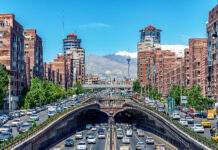by Subir Bhaumik* (from Calcutta, India)
Operation 1027, the military offensive launched by a group of ethnic rebel armies last year, entered a decisive second phase last week with a furious assault on the town of Lashio on the China-Myanmar border.
This strategic town had been spared in the first offensive launched by the Three Brothers Alliance between October last year and January. It is the headquarters of the northeastern command of the Tatmadaw (Burmese army). Possession of the town is so important to the beleaguered Tatmadaw that a serving major general warned in January that Commander-in-Chief Min Aung Hlaing could be removed if he lost control of Lashio.
The Myanmar National Democratic Alliance Army, the Ta’ang National Liberation Army and allied groups have reportedly attacked at least five bases around the town. Initial reports suggest that at least two outposts have already fallen. Meanwhile, China has cut off electricity to Laukkai town, the capital of the Kokang region, which fell to the MNDAA in early January. Since Wednesday, people have been stockpiling rice, cooking oil and gas amid the uncertainty in Laukkai.
“Wealthy people are temporarily fleeing to the Wa region,” the Frontier Myanmar website quoted a source as saying, referring to the area controlled by the United Wa State Army.
Morgan Michaels, an analyst at the International Institute for Strategic Studies, said on X that authorities in China’s Yunnan province had cut off electricity, water and internet to Laukkai ‘in response to the MNDAA’s attempt to encircle the regime-controlled town of Lashio’. The Special Advisory Council on Myanmar (SAC-M), an independent advisory group co-founded by three UN officials, has noted that the ruling military junta has lost significant territorial control to armed resistance and insurgent groups since the start of the 1027 offensive last year. The SAC-M report argues that the junta now holds insufficient territory to be considered a legitimate government.
The report states that the overall trajectory of the conflict in Myanmar since 2022 has been one of ‘expanding resistance control against corresponding military junta losses’. Since ethnic armed groups and anti-coup fighters known as the People’s Defence Forces (PDF) launched Operation 1027 last year, they have made significant advances, capturing military posts and border towns in the north and east, along the border with China and Thailand, and in the west where Myanmar meets Bangladesh and India, the SAC-M report said.
The SAC-M said the generals had lost complete authority over the townships, which cover 86% of the country’s territory and are home to 67% of Myanmar’s 55 million people. “Resistance to the junta’s control remains strong, widespread and deeply rooted,” it said.
According to the Assistance Association for Political Prisoners, 5,161 civilians have been killed since the February 2021 coup and 20,500 prisoners are being held in jails – all pointing to a serious human rights situation. The military junta’s desperate measures to turn the tide have not helped.
What is India’s option? In late June, Indian Foreign Secretary S Jaishankar told his Myanmar counterpart U Than Shwe of India’s ‘serious concern over the impact of the continuing violence in Myanmar’.
Jaishankar also called for an early return to the path of democratic transition in Myanmar and said that India was “open to engaging all stakeholders in addressing this situation.” There is still a sense that India is too soft in its approach to the Burmese military junta, and not nearly strong enough in its pressure to bring the generals to the table. Perhaps it fears too much pressure will push the generals towards China, but they are already in Beijing’s pocket.
India has the unique advantage of having links with all the major players – the army, the ethnic rebel groups, the democratic parties, including Aung Saan Suu Kyi’s NLD, and the parallel National Unity Government, which has now been allowed to open a liaison office in Delhi. So it is no longer a good idea to leave the Burmese peace process to ASEAN, which has utterly failed to break the ice with its 5-point consensus.
India will never be counted as a major power unless it plays a meaningful role in crises like Myanmar. Grandstanding by hosting events like G20 summits does not make India a power, timely intervention in a situation like Myanmar does. Let’s remember 1971 and the role India played in the liberation of Bangladesh. This not only helped India to emerge as the prima donna in South Asia but also as a country that cannot be wished away.
Exit strategy for the generals!
This is the time for India to extend not just an olive branch but the promise of an exit strategy for the generals. Their survival – at least as leaders of a cohesive military – depends on negotiations with the various stakeholders, because despite heavy arms purchases from at least 13 countries (which many like SAC-M want to stop), the junta cannot regain lost territory. The failure of the recent counter-offensive in Rakhine (Arakan) State proves this. The junta may not yet be in a ‘negotiate or perish’ situation, but its position is not much better.
On the cover photo, Myanmar map infographic elements with flag of city. Separate of heading is total areas, currency, language and the capital city in this country ©stu-khaii/Shutterstock.com
* Subir Bhaumik is a former BBC and Reuters correspondent and author of five books on South Asian conflicts
























